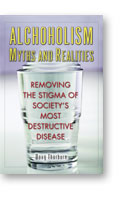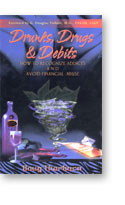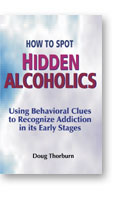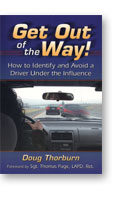 |
|
Welcome to the Thorburn Addiction Report. Each month, we bring you several sections, including:
1. Top Story-of-the-Month
2. Review-of-the-Month
3. Dear Doug in which a recent letter to "Dear Annie" or other "help" column is rewritten, with responses given from the unique perspective that alcohol or other drug addiction best explains the misbehaviors described
4. Alcoholic Myth-of-the-Month
5. Alcoholic Antic-of-the-Month
There is something for everyone!
|
|
| How Many Times Will
Kennedy Fans Enable Before he Dies from his
Disease?
 The
cops do what they can to prevent another attempt at sobriety, but
(fortunately) fail The
cops do what they can to prevent another attempt at sobriety, but
(fortunately) fail
Rep. Patrick J. Kennedy, six-term
congressman from Rhode Island, entered rehab—again—for an admitted
addiction to pharmaceuticals after crashing his car. He remembered nothing
of the incident (meaning he was in a blackout), which occurred May 4th at
3 a.m. A police report stated at the time of the accident Kennedy’s “eyes
were red and watery, speech was slightly slurred and, upon exiting his
vehicle, his balance was unsure…. [His car] had no lights running” and
almost swerved into a police car traveling in the opposite direction. When
an officer tried to stop him, Kennedy “did not respond but continued at a
slower speed,” finally colliding head-on with vehicle barriers placed
around the Capitol after 9-11.
There may be two parts to this
story that could prove more interesting than Kennedy’s relapse, but which
the media will all but ignore. One is the cops, who attempted—no doubt,
yet again—to enable Kennedy by protecting him from appropriate
consequences for misbehaviors. We can only guess how many hundreds or even
thousands of times his poor conduct failed to make news, when a friend,
family member, fellow congressperson or law enforcer enabled Patrick J.
Kennedy. In this instance, the officers who were involved sought to give a
breath test, but were overruled by the watch commander and told to leave
the scene so higher-ups could take Kennedy home. Kennedy and others whom
he will come into future contact with got lucky: the publicity seems to
have forced him into rehab.
The other overlooked part to the
story may be the doctors, who provided a known addict with a prescription
to at least one psychotropic drug. Kennedy admitted to having Phenergan
and Ambien in his system. Ambien, a sedative-hypnotic (think: Valium), by
itself causes problem behaviors in addicts. The warning label clearly
states, “The habit-forming potential is high. Psychological and physical
dependence is possible…[If you stop using this drug, there may be]
physical withdrawal symptoms.” In other words, it’s an addictive drug,
which you don’t give to addicts. The label also says, “Do not take this
drug with any other drug that might slow the central nervous system, like
another sedative, benzodiazepine, sleeping pills, monoamine oxidase
inhibitor, antipsychotics, anticonvulsants, or antihistamines.” Phenergan
is an antihistamine. You don’t compound the destructive potential by
providing drugs to an addict that could prove deadly in combination.
Addicts frequently ignore warning labels.
This is not the first
time his antics have appeared on the front pages. The youngest of three
children of alcoholics Sen. Edward M. Kennedy and former wife Joan Kennedy, Patrick Kennedy was admitted to rehab after getting
caught with cocaine in 1986 at age 18. In 2000, he shoved a security guard
at Los Angeles International Airport when she told him he had to check his
bag because it was too large to carry on board. He settled a lawsuit she
brought against him for an undisclosed sum out of court. In 2001, the
Coast Guard was called to his rented yacht to intervene in an argument
with his girlfriend, who said he had been drinking. It must have been
quite a scene, as he was accused of causing $28,000 in damage to the boat.
Five months ago he sought treatment for his psychotropic drug addiction.
Just a month before this latest incident he was reportedly at fault in a
two-car accident in Portsmouth, RI, as he was “hurrying into the parking
lot of a pharmacy.” Any one of these behaviors suggest an almost certain
likelihood of addiction: a young person in the public eye using an illegal
drug (one would expect non-alcoholic children of famous people to shy away
from controversy); a sense of entitlement and a “rules don’t apply to me”
attitude; arguing while drinking to the point at which law enforcers are
called to the scene; damaging property while drinking; prior stays in
rehab; causing an accident because he was in a hurry (at a pharmacy, no
less). How many more incidents might have escaped public
notice?
A Rhode Islander is reported to have said, “People
accept the Kennedy’s. Everyone knows they’re going to get in trouble—and
everyone knows they’ll get out of it.” Yes, as long as there are enablers
willing to protect alcoholics from proper consequences. Such enablers need
to be reminded that as long as they are willing, the odds of sobriety are
greatly reduced and the likelihood of real tragedies ultimately occurring
are dramatically increased.
Runners-up for top story
of the month:
Sudanese President Omar al-Bashir,
who told a reporter inquiring about reports of evacuations, extreme
poverty, mass killings and gang rapes in Darfur, “These are all lies. I
tell you these are lies. There is no mass killing.” Sudan, the largest
country in Africa at nearly a third the size of the lower 48 States, has a
per capita gross income of $530, 1,200 miles of paved and gravel roads
(the U.S. has 2.4 million miles of such roads) and six million internally
displaced refugees, 61 per cent of whom have experienced a family member
killed in its Civil War.
Actor Kiefer Sutherland,
reportedly throwing a tantrum in a Tennessee restaurant after being asked
to smoke outside by a busboy, Nathan Rush, who was fired after the
incident. Rush is quoted as saying that Kiefer told the manager his party
was leaving because he “sprayed food and drinks at him.” This is the
latest in a run of misbehaviors that seem to be worsening, a concern for
those who enjoy Sutherland’s character Jack Bauer in “24.” But then,
that’s the nature of alcoholism: it only gets worse.
Former
Playboy Playmate and would-be heiress Anna Nicole Smith, who won a
unanimous ruling from the Supreme Court, clearing the way for further
legal battles over $500 million from the estate of her late husband, J.
Howard Marshall. A Texas oil billionaire, Marshall was worth $1.6 billion
when he died in 1995 at age 89 after marrying the then 26-year-old Smith
in 1994. The high court’s review was made possible because Smith had filed
for bankruptcy, creating a legal quagmire over which had priority: a
federal bankruptcy court in California or a Texas probate court. The 9th
Circuit Court of Appeals threw out Smith’s award after deciding that
federal bankruptcy judges had no right to intervene in state probate
matters. Because this would have crimped the IRS’s ability to collect
taxes owed by an estate, the Justice Department sided with Smith and the
bankruptcy court. Who else but an alcoholic could bring together the
Supreme Court, the Justice Department, the IRS and a Playmate all in one
story?
Los Angeles Lakers center-forward Kwame Brown,
under investigation for sexual assault. Brown, the No. 1 pick in the 2001
draft, reportedly clashed with Michael Jordan and Wizard Coach Eddie
Jordan. He was arrested in 2002 on suspicion of driving 120 mph and
arrested again in 2003 on suspicion of DUI.
Former Georgia
state school superintendent Linda Schrenko, who in 1994 was the first
woman to win statewide office in Georgia, pleading guilty to defrauding
the government and money laundering. Among other violations, Schrenko and
her boyfriend funneled federal school money into a $9,300 face-lift and
her 2002 campaign for governor. After the election, she split from her
husband (yes, she was married and had a boyfriend) and filed for
bankruptcy. Even political opponents were shocked at her fall from grace,
including former Gov. Roy Barnes who said that Schrenko was “blinded by
something—I never could understand what it was—and it led to her
downfall.” How about the fact that her staffers said she was drug-addled
and rarely showed up for work? Then again, all we need to know is she
bankrupted almost $70,000 in credit card debt and tens of thousands in
medical bills while earning $113,000 per year. Memo to Gov. Barnes: she
was blinded by distortions of perception and memory that made her think
she could do no wrong, a byproduct of long-standing alcohol and other-drug
addiction.
Under watch:
Helen
Golay, 75, and Olga Rutterschmidt, 72, who allegedly offered room and
board to Los Angeles area homeless men in exchange for their cooperation
in applying for insurance policies on the men’s lives. More than $2
million was collected from policies, which paid off when the men were
killed in mysterious hit-and-run crashes. The women initially took out
small policies but duplicated the men’s signatures on rubber stamps, which
were used to obtain more policies, keeping each policy small enough to
stay under life insurers’ fraud radar. They were caught only when two
detectives were sharing “war” stories and realized an unsolved murder of a
homeless man in 1999 was similar to another one in 2005, both of which
involved the two elderly women collecting insurance. This “Arsenic and Old
Lace” story is already proving to have “legs” on par with that of Stefan
Eriksson, who crashed an Enzo Ferrari into a power pole on Pacific Coast
Highway at 162 mph in February.
Bolivian President Evo
Morales, leading his country towards despotism via the ballot box with
the aid of Venezuelan President Hugo Chavez. As money is the addict’s
biggest enabler, so it is with despots, including those masquerading as
populists. Whether his government will be as irresponsible as his
rhetoric, which is virulently anti-American, will depend upon whether or
not he is an alcoholic. Unfortunately, I suspect Morales and Chavez are
drinking buddies, with Morales following in his footsteps by attempting to
draft a new constitution, which was Chavez’s main legal tool for
concentrating power into his own hands. Recall that Hitler, whose drugs of
choice were amphetamines and barbiturates, was also elected
democratically.
Financial commentator Louis Rukeyser,
who delivered the fun- and pun-filled commentary on economic and financial
events for over three decades as host of “Wall $treet Week With Louis
Rukeyser,” dead at age 73 from a rare bone cancer. Rukeyser was considered
warm, witty, highly intelligent and charming by almost all his viewers.
Peering through the veil, there were several public and inexplicable
events that raised my antennae: he capriciously fired long-standing
panelists on at least two occasions and lambasted a guest with whom he
happened to disagree more than once. Since his style was generally
non-confrontational and interviews were intended to extract as much
information as possible from both panelists and guests, this made no sense
until I asked, was Louis Rukeyser a hidden alcoholic?
His
refusal to do a small favor for a cruise ship’s captain, Loren McIntyre,
reported in a 1991 Inc. Magazine article by author Michael Lewis,
was a petty but telling incident. The captain needed to have a cassette
mailed and heard that Rukeyser was leaving the cruise early. Rukeyser was
reluctant, but finally agreed to take the tape when the captain all but
begged him. McIntyre asked Rukeyser to write his name and phone number
down, in case something went wrong. Rukeyser asked, “You mean you don’t
know who I am?” McIntyre admitted he had no idea. Rukeyser responded, “If
you have to ask that, I’m not taking it,” and marched out without the
cassette. It is little, seemingly unimportant incidents such as this,
suggesting an inordinately large sense of self-importance, that have often
been my first clue to alcoholism.
Also notable were his disdain
for being upstaged, some raucous partying where alcohol was served and a
love of gambling, all of which are consistent with alcoholism. But despite
several hours of research including interviews with a number of people who
knew him, I found no hard evidence of addictive use. Few, even those who
related bitter feelings in private, were willing to go on the record
saying anything negative about Rukeyser, avoiding what many might consider
an attack on a dead person who can’t defend himself. Still, while most
seem to have enjoyed his public persona (including this correspondent),
one explanation for Rukeyser’s occasional personality defects and
capriciousness—love him or not—is alcoholism.
Codependent of
the Month: The U.S. Army. If the incident in Haditha proves true, we
can look to soldiers with symptoms of alcoholism as the source of the
atrocities. According to the Los Angeles Times, at least one
prisoner told investigators that “he frequently smelled alcohol on the
guards’ breath in the cellblock where most of the abuses occurred” at Abu
Ghraib (June 13, 2004). Who doubts that alcohol and other-drug addiction
wasn’t at the root of Viet Nam atrocities, particularly My Lai. Due to the
possible misbehaviors of a few, all U.S. soldiers will be subjected to
“ethics training.” Unfortunately, such training offers no benefit for
those in whom the biological processing of alcohol damages the seat of
reason and logic, the brain's neo-cortex.
Note
to family, friends and fans of the above: the benefit of the doubt is
given by assuming alcoholism (they are either idiots and fundamentally
rotten, or they are alcoholic/other drug addicts—which would explain the
misbehaviors). If alcoholic, there is zero chance that behaviors, in the
long run, will improve without sobriety. An essential prerequisite to
sobriety is the cessation of enabling, allowing pain and crises to build.
Thus far, many have done everything they can to protect the addict from
the requisite pain, making these news events possible. The cure for
alcoholism, consequential bad behaviors and, ultimately, tragedy, is
simple: stop protecting the addict from the logical consequences of
misbehaviors and proactively intervene.
|
|
 Review: “The Kennedy Curse: Why Tragedy Has
Haunted America’s First Family for 150 Years,” by Edward
Klein Review: “The Kennedy Curse: Why Tragedy Has
Haunted America’s First Family for 150 Years,” by Edward
Klein
Edward Klein covered John F. Kennedy’s 1960
Presidential campaign and later served as foreign editor of Newsweek and editor-in-chief of The New York Times Magazine.
He has authored countless articles and several books, including two others
on Kennedy family members. He’s a good writer and meticulous researcher.
However, despite his resume and, sadly, in concert with virtually every
other biographer and historian, he reverses cause and
effect.
As discussed in by books, How to Spot Hidden
Alcoholics: Using Behavioral Clues to Identify Addiction in its Early
Stages, and Alcoholism Myths and Realities: Removing the Stigma of
Society’s Most Destructive Disease, alcoholism mimics virtually all
the Personality Disorders, particularly Narcissism. A diagnosis of this
Disorder requires any five attributes out of a menu of nine, including “a
grandiose sense of self-importance,” “a belief he is ‘special,’” “a sense
of entitlement” and an “arrogant and haughty attitude.” These, as well as
the other five attributes, are all classic symptoms of alcoholism or
severe codependency, especially in children of
alcoholics.
According to studies cited in my first book, Drunks, Drugs & Debits: How to Recognize Addicts and Avoid Financial
Abuse, 70-80% of recovering addicts with two or three months of
sobriety who were diagnosed with a Personality Disorder when drinking are
found to have been misdiagnosed. While most Disorders clear up or become
far less of a concern after two to three years of sobriety, experience
shows that what most consider normal behaviors usually don’t return for
five to ten years.
Klein includes vignettes on a potpourri of
Kennedy clan members, some alcoholics and several children of alcoholics.
The manifestation of narcissism in apparent non-alcoholic members of the
family, including Joe Kennedy’s favorite daughter Kathleen, suggests the
power of familial alcoholism. Extraordinary tolerance to alcohol makes the
disease all but invisible in many, including Joseph P. Kennedy, even while
numerous behavioral indications of the disease are evident (I counted two
dozen such clues in the 45-page chapter on Joe, from attempts at blackmail
to hyperbole and a public display in which he flouted long tradition). The
fact that narcissism can be so obvious in non-alcoholics, as well as in
those who defy the diagnosis, may account for the fact that alcoholism is
overlooked as the most common root of the Disorder. However, the likely
underlying cause becomes more apparent when we realize that a confluence
of narcissists is found in families in which alcoholism is epidemic.
The Kennedy Curse is billed as a “detective story”.
Unfortunately, Edward Klein helps to perpetuate the myth that most
character flaws are inherent, when they are instead usually rooted in
alcoholism. While including some interesting and telling depictions in the
lives of alcoholics and their codependents in what may be America’s most
famous family, Klein’s book fails in its most fundamental
goal.
|
 |
Dear Doug: Backstabbing
Employee
Dear Doug:
One of my subordinates
invariably puts himself in a positive light at my expense in front of my
manager. He’s either not truthful or fails to give the whole story. Should
I say something or let it
go?
Signed,
Slighted
. . .
.
Dear Slighted,
Other columnists might suggest
that you carefully, professionally and in a mature way correct his
comments, so that your manager doesn’t buy into the misinformation. Such
columnists might also suggest a private encounter with the employee,
letting him know you expect the cheap shots to stop. There might even be
an allusion to the behavior as a “power game.” Indeed.
Left
unsaid is that power-seeking behaviors, especially those coming at the
expense of others, are frequently connected to alcoholism. You should look
for supporting behavioral indications of addiction such as trouble at
home, belittling and disparaging remarks about others and regular visits
to bars after work. If such clues exist, assume that his lies and
insinuations will worsen. Then, you must do everything you can to protect
yourself. This would include having incontrovertible proof that any
allegations he makes are false, as well as planning for the likelihood
that his lies will be more believable than your truths. And whatever you
do, don’t confront him one-on-one. Such confrontations are breeding
grounds for false accusations by alcoholics.
(Source for story
idea: Ken Lloyd, Ph.D., Management Consultant, The Daily News, May
8, 2006.)
Prevent Tragedy Foundation
|

“There’s certainly a streak of recklessness in the
family, despite how much they’ve achieved.”
So said Ron
Kessler, author of a book on the Kennedy clan’s patriarch, Joseph P.
Kennedy (The Sins of the Father: Joseph P. Kennedy and the Dynasty He
Founded), in commenting on the family’s latest front-page antics.
Unfortunately, Mr. Kessler lacks an understanding of the key ingredient to
alcoholism: a biochemistry that, with use, causes addicts to view
themselves as godlike. This egotistical self-perception makes the addict
truly believe he or she is invincible, which often manifests in reckless
behaviors. And, those who think they're God tend to develop a need to
control others. Overachievement provides a ready means by which to control
fans, constituents, co-workers, employees, friends and family. As a
result, reckless behaviors do not occur despite achievement in
alcoholics; rather, alcoholism impels the addict to engage in
reckless behaviors and overachieve.
And this month, a
bonus myth-of-the-month:
“The defendant, unquestionably, had
some mental issues.”
So said Assistant District Attorney
Bob Gordon, in describing the mental state of Jan Erickson, 28, who was
found guilty in April of murdering his father, Stephan Erickson, 65. Jan
stabbed his father 37 times and used a meat cleaver to castrate him in
what police said was one of the most horrific crime scenes in recent
memory. The victim reportedly fed his 20-something, troubled, unemployed
and crack-addicted son and let him live with him rent-free. His mother
testified that she indulged her son by shopping, job-hunting, using
methamphetamine with him and helping him solicit transvestite prostitutes
(meth addicts truly do the craziest things). His sister, perhaps
unknowingly lending support to the idea that addiction has nothing to do
with upbringing, testified that the family previously had a nice life in
Marin County, California. Erickson explained that he committed the murder
because his father coddled him and fostered his drug addiction, but failed
to explain why he didn’t take out his mother as well.
Yes Mr.
Gordon, Jan Erickson had mental issues. Most people who hear such comments
probably think of Bipolar or other Personality Disorder. They would be
misled. Jan Erickson was simply an addict. As such, he was capable of
anything.
Jan was right, however, about his father enabling
him. If Stephan Erickson had understood the imperative of
addiction—uncompromising disenabling and intervention at the earliest
possible moment—he might be alive today and his son might be a sober and
free man.
|

Amazing
Antics: Stories of Alcoholism-Driven
Behaviors™
Story from “This is True” by Randy
Cassingham, with his “tagline:”
These antics involve law
enforcers who, like Kennedy in this month’s top story, could have easily
cost lives.
“WHO CONTROLS THE CONTROLLERS? ‘Due to circumstances that I deeply regret,’ said Teresa L. Kaiser, 56, she resigned as the executive director of the Oregon Liquor Control Commission. What sort of circumstances? While driving -- not in a state car, her deputy was quick to point out -- she swerved into oncoming traffic, causing a crash with injuries, and was arrested after her blood alcohol was shown by a breath test to be double the legal limit. Kaiser told police she
had only drunk two glasses of wine over several hours, but a chart released by her own agency notes that a person of her weight would have to consume six drinks in one hour to achieve a blood-alcohol level of 0.16 percent. (Portland Oregonian) ...If cops got a dollar for every driver who ‘only had two,’ we wouldn't have to pay them.”
All
too often, law enforcers have undiagnosed and untreated alcoholism. While
most of the time doing their job—and oftentimes, like so many addicts,
doing it well—they will sometimes falter and violate the rules they
enforce. All the while, there is usually some degree of abusive behaviors
going on behind closed doors. I have known women “happily” married to law
enforcers for fifty years who, after the spouse died, admitted they were
verbally (if not physically) abused the entire time.
Here we
have a law enforcer whose job it is to protect underage drinkers from
gaining access to the drug alcohol, when she is the one who needs such
protection. She’s 56, not 26, with a BAL of .16 per cent. She lied
because, well, that’s what alcoholics do. She was behind the wheel of a
car at a BAL of over .15 per cent which, while not a concrete limit for a
certain diagnosis of alcoholism, is surpassed by few other clues in terms
of the degree of certainty. There are few if any instances in which a
driver over the legal limit who claims that he or she “only had two”
doesn’t have this disease. It would be interesting to ascertain how many
lives she has ruined and relationships destroyed while her alcoholism has
likely progressed for some 40 years.
Cassingham’s tagline is an
insightful one. Cops deal almost exclusively with those having alcohol or
other-drug addiction and would do well if they could collect a buck for
every contact, virtually all of whom would say if asked, “But officer, I
only had two,” or “the drugs belong to my friend; I don’t know how they
got there.”
And this month, a bonus antic involving two more
law enforcers:
“ALL IN THE FAMILY: Police in Columbia Heights, Minn., struggled to get control over a couple after an alleged drunk driving accident. The female half of the couple, Lindsay E. Anderson, 29, hit a parked truck and then a car at 1:00 a.m. Her fiancé, Steven J. Herron, 34, allegedly refused to submit to arrest and had to be stunned with a Taser twice to place him in restraints. Anderson was charged with driving while intoxicated with a blood alcohol level of .213 percent, and Herron was charged with "obstructing the legal process." Both were booked into jail -- a place they know well since both Anderson and Herron are police officers in nearby Minneapolis. Both were placed on desk duty pending the results of an investigation. They won't be allowed to drive police cars, but were allowed to keep their guns. (Minneapolis Star Tribune) ...And, I hope, just one bullet
in their shirt pockets.”
Since tolerance usually decreases
later in life, the difference between a 29 or 34-year-old alcoholic and
one who is 56 is in the blood alcohol level at which point trouble ensues.
Kaiser showed obvious signs of inebriation at a substantially lower BAL.
In both cases, due to the heavy drinking and serious misbehaviors, there
should be no question about alcoholism. Their superiors don’t seem to
grasp the idea that a person with this disease is capable of anything. A
gun—even with only one bullet in the pocket (very clever, Randy)—is the
last thing they should be allowed to possess after proving to society they
have a disorder that causes them to process the drug alcohol in such a way
as to cause them to intermittently act badly in unpredictable
ways.
(Story and tagline from “This is True,” copyright
2006 by Randy Cassingham, used with permission. See
http://www.thisistrue.com for free
subscriptions.)
Visit
www.thisistrue.com for free subscriptions |
Comments
To view reader's comments on last month's Thorburn Addiction Report and Doug's responses please visit the Thorburn Weblog at PrevenTragedy.com.
Doug frequently posts alcoholism-related articles, as well as his responses, so be sure to check back often.
Thorburn Weblog
|
Doug's new book, Alcoholism Myths and Realities, is now available at
GaltPublishing.com, Amazon.com and bookstores near you.
"Every policymaker in America needs to read your book exposing the myths of chemical addiction...Excellent book."
— Jim Ramstad, Member of U.S. Congress (MN)
"My father died of alcoholism. His father died of alcoholism. Three generations of alcoholism is enough. Now is the time to abandon superstition and pseudoscience, to debunk the myths surrounding alcoholism, and to apply science to solving this problem. Doug Thorburn's book is a model example of how this should be done. Read it and be prepared to change your thinking on this important topic. When enough of us understand what is really going on with alcoholism, society can make the shift from treatment to prevention and intervention."
— Michael Shermer, publisher, Skeptic Magazine and columnist, Scientific American
Buy your copy of Alcoholism Myths and Realities for only $14.95 or get the whole collection PLUS a two-hour audio cassette from Galt Publishing for just $49.95 plus tax and shipping. That's a $72.75 value for only $49.95.
To order online, click the following link (be sure to put "TAR SPECIAL" in the comments section of the order form.) Orders can also be placed by phone: 800-482-9424 OR fax: 818-363-3111.
If you wish to pay by check, send the appropriate payment with your shipping information and the words "TAR SPECIAL" in the "memo" section of your check to: PO Box 7777, Northridge, CA 91327.
To purchase any of the above Thorburn books, go to www.galtpublishing.com |

Have you visited the Prevent Tragedy Foundation" The Prevent Tragedy Foundation is a tax-exempt 501c-3 organization, the goal of which is to educate the general public on the need for early detection of alcohol and other drug addiction. The Foundation is intended to answer a question that has been all-but-ignored by similar organizations: what does alcoholism look like before it becomes obvious"
Click here to visit the Prevent Tragedy Foundation |
|
Subscriptions
The Thorburn Addiction Report is a free newsletter published by Galt Publishing and PrevenTragedy.com. Subscibe by visiting our web site at www.PrevenTragedy.com.
Click here to visit PrevenTragedy.com
|
The Thorburn Addiction Report is available to newspapers as a regular feature column.
Inquiries are invited.
Copyright 2006 Doug Thorburn All Rights Reserved.
ALL broadcast, publication, retransmission to e-mail lists, WWW or any other copying or storage, in any medium, online or not, is strictly prohibited without prior written permission from the author. Manual forwarding by e-mail to friends is allowed if 1) the newsletter is forwarded in its entirety and 2) no fee is charged. Please forward no more than three issues to any one person -- after that, they should get their own free subscription. We appreciate people who report violations of our copyright to us.
TO COMMENT to the author,
send your email to report@preventragedy.com or write to
Doug Thorburn, P.O. Box 7777, Northridge, CA 91327-7777
|
 |





 Review: “The Kennedy Curse: Why Tragedy Has
Haunted America’s First Family for 150 Years,” by Edward
Klein
Review: “The Kennedy Curse: Why Tragedy Has
Haunted America’s First Family for 150 Years,” by Edward
Klein



